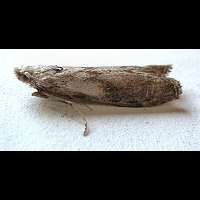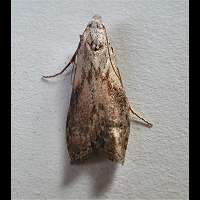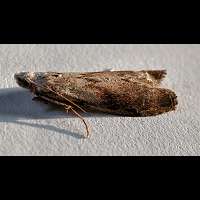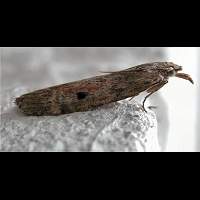Bee Moth Aphomia sociella
There is a remarkable difference between Bee Moth males and females. The female is bigger, mostly brownish and shows three clear bandings on the front wing, separated by a sharp zig zag line. There is a big black point in the middle band, the so-called discal spot. The hind wing is almost entirely lightbrown. The male is smaller and more contrasting. The first part of the wing is white with a brownish impression. The rest of the wing is brownish, dark first, but getting lighter towards the top of the wing. The zig zags are only partially visible and the wing is not clearly divided into three bands. The hindwing is whitish brown and much lighter than the female's. The males are easy to identify, for there are no similar species. Females are slightly more complicated to identify. The wingspan is some 25 to 33 mm for the male and some 30 to 38 mm for the female. All animals in the pictures on this page are males. Except for the animal in the bottom picture, which is a female.
The eggs are being laid in summer and hatch quickly. The larvae may continue to feed until pupation time in spring. The caterpillars live in the nests of bumblebees and social wasps mainly. It rarely lives in bee hives. After hatching the larvae feed in debris within the nest. But when that finishes they'll be eating the comb. And they'll not stop there, for they'll eat the bee or wasp larvae as well. This makes them rather unique, for most moth larvae are strict vegetarians. To move through the nest unattacked they'll spin a kind of tunnels running all through the nest. If a nest gets contaminated by the Bee Moth it will be completely destroyed in the end. The larvae are yellowish white, with vague yellowish markings on top en very small, black spiracula. They make a maggot like impression and reach a length of some 13 mm.
The Bee Moth is on the wing in June, July and August. It flies by night only and is regularly attracted by light. This is uncommon in wax moths, for most species are not lured to light. By day it rests in low vegetation and can be found on walls, fences or tree trunks from time to time. In such a case photographing the animal is easy, for it is not quickly disturbed at all.
The Bee Moth is a member of a small subfamily of the Pyralids called the Wax Moths (Galleriinae). A number of species within this family lives on wax, hence the name. The Bee Moth is found in nests, usually above the ground, of bumble bees and social wasps. It is not keen on bee hives. But two of its relatives are: the Wax Moth and the Lesser Wax Moth. Both are feared by bee keepers, especially the Lesser Wax Moth.
There is a remarkable difference between Bee Moth males and females. The female is bigger, mostly brownish and shows three clear bandings on the front wing, separated by a sharp zig zag line. There is a big black point in the middle band, the so-called discal spot. The hind wing is almost entirely lightbrown. The male is smaller and more contrasting. The first part of the wing is white with a brownish impression. The rest of the wing is brownish, dark first, but getting lighter towards the top of the wing. The zig zags are only partially visible and the wing is not clearly divided into three bands. The hindwing is whitish brown and much lighter than the female's. The males are easy to identify, for there are no similar species. Females are slightly more complicated to identify. The wingspan is some 25 to 33 mm for the male and some 30 to 38 mm for the female. All animals in the pictures on this page are males. Except for the animal in the bottom picture, which is a female.
The eggs are being laid in summer and hatch quickly. The larvae may continue to feed until pupation time in spring. The caterpillars live in the nests of bumblebees and social wasps mainly. It rarely lives in bee hives. After hatching the larvae feed in debris within the nest. But when that finishes they'll be eating the comb. And they'll not stop there, for they'll eat the bee or wasp larvae as well. This makes them rather unique, for most moth larvae are strict vegetarians. To move through the nest unattacked they'll spin a kind of tunnels running all through the nest. If a nest gets contaminated by the Bee Moth it will be completely destroyed in the end. The larvae are yellowish white, with vague yellowish markings on top en very small, black spiracula. They make a maggot like impression and reach a length of some 13 mm.
The Bee Moth is on the wing in June, July and August. It flies by night only and is regularly attracted by light. This is uncommon in wax moths, for most species are not lured to light. By day it rests in low vegetation and can be found on walls, fences or tree trunks from time to time. In such a case photographing the animal is easy, for it is not quickly disturbed at all.
The Bee Moth is a member of a small subfamily of the Pyralids called the Wax Moths (Galleriinae). A number of species within this family lives on wax, hence the name. The Bee Moth is found in nests, usually above the ground, of bumble bees and social wasps. It is not keen on bee hives. But two of its relatives are: the Wax Moth and the Lesser Wax Moth. Both are feared by bee keepers, especially the Lesser Wax Moth.









